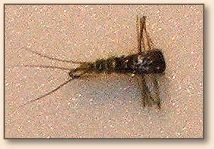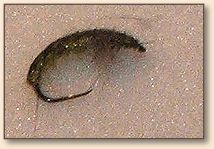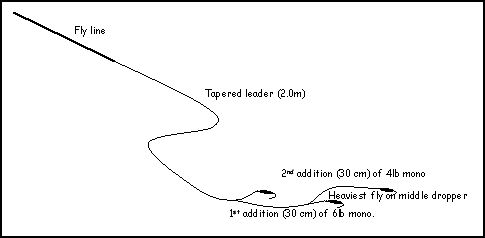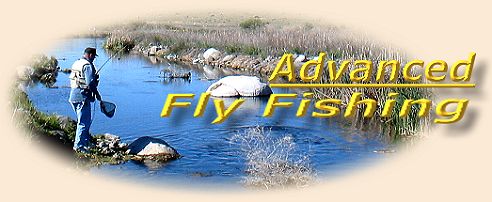|
In 1990 the Polish and Czech fly fishers cleaned up
at the World Fly Fishing Championship when the
competition was held in Wales. They won both Gold
and Silver in the team events and all were highly
rated in the individual places.
When the event was run in the Czech Republic in 1996,
these two teams were again highly placed. So what was
it they were doing differently?
I first started reading about Czech nymphing when
Oliver Edwards commenced a series of articles in
the British Fly Tying and Fly Fishing
magazine. Oliver is one of the best known fly tiers
in the UK and represented England in the 1996
championships. I have kept up with his writings on
this subject and have enthusiastically delved into
his publications and DVD's. A lot of articles are
now being published by other fishing writers who
put themselves at the forefront of this technique.
Not so, Oliver is without doubt the leader of this
new tactic in the United Kingdom with a vast knowledge
of the subject having fished with the Polish and Czech
experts.
As I am now residing in the United Kingdom I wanted
to get an even better understanding and embellish my
trout fishing techniques as, like a lot of Australians,
I spend a good deal of time fishing still waters in New
South Wales and Tasmania.
I am fortunate to be living close to the Wharfe River
in Yorkshire in England and have an annual license to
fish five miles of the river at Bolton Abbey.
Bolton Abbey was destroyed by Henry viii in his attempt
to impose the newly formed Church of England on all the
Abbeys across England and extract the vast wealth that
they had accumulated over centuries. The river is a
typical freestone river not too dissimilar to the
Goulburn River in Victoria. At one spot the river
enters a short gorge and in this area it is very
reminiscent of the upper Kiewa River in that same state.
What about the patterns? Given that most of what trout
eat (and grayling in the northern hemisphere) are
subsurface, then it goes without saying that I needed
to make sure that I had the correct patterns. Oliver
Edwards would advocate that you undertake a small
insect survey to find out what food type was in the
area that you were about to fish. I have to agree.
The methods used for this type of fishing means that
the fish will get a very close look at what you are
offering to them. No general patterns here. You will
catch fish but not as many if you are fussier with
your designs. Try it. If you take a small seine net
and kick up gravel into it you will get a good idea
of what is on the diet of trout in that area. I actually
use a piece of mosquito netting sewn into a 'bag' which
I simply slide over my net. Easy to use and it doesn't
take up too much room in my vest.
When I did it, I got lots of samples of Caddis grubs,
mayfly nymphs, damsel nymphs and small crustaceans,
the caddis grub being the most prominent followed
closely by mayflies.
I have long believed that Caddis is the staple diet
of trout in our Australian streams.
When I was instructing people on fly fishing a few years
ago I classed trout food into five classes so that the
students could quickly understand the food chain and
group them into fly patterns. They are: 'the shredders'
- those that chew up things that are either growing in
or fall into the water; 'the catchers' - those that
catch the by-product of the 'shredders'; the 'scrapers'
- those that keep the water clean by feeding on algae's;
'the terrestrials' - those that fall into the water and
'the predators' - those that prey on everything else
including their own species.
I found 'shredders', 'scrapers' and 'catchers' everywhere.
This made it easy for me to begin the development of
patterns.
Rivers and streams are funny places. Some times you get
to the bank and you would swear that the water was barren
of fish and food. Other times the opposite. My observation
is this, if you count all the items of food that you found
during your survey, then multiply it by the stream bed area
in front of you and then extend that to the whole stream
you soon get a good idea of just how much food is available
to the fish without even coming to the top to feed. I surmise
you only get to see 15-20% of the fish even on the best of days.
Given that current speed is much slower at the bottom
of streams and that river fish won't over exercise
themselves too much to feed, then it is logical that
the majority of fish will hold where the current is
less. So where do you need to fish? On the bottom!
I am sure we have all read that nymphs and larva are
dislodged or loose their adherence to the rocks, stones,
gravel and debris that lies on the bottom of rivers and
streams. It is this knowledge that the Polish and Czech
fly fishers have capitalised upon. The first part of the
equation is what flies to use?
Czech nymphing as it is known (the Polish seem to have
converged into this term) requires flies that are heavy
and a fairly accurate match to the type of insect that
is being imitated. Even Frank Sawyer knew this as his
flies matched the need to get down to the fish and
represent the insects in his beloved Avon River. So
it is not new.
Lead is added to the flies as an under body and a good
deal of it, ('tho it is not legal everywhere). I fish
with two patterns here in the UK and I am certain the
same patterns would work just as well at home and even
in the rivers on the south island of New Zealand. I
have flies, in various sizes and colour that match the
various caddis and mayflies species. The 'shredders,
'scrapers' and 'predators' of these two species. The
caddis 'grub' is tied on 'Czech' nymph hooks (which I
get direct from the supplier, chemically sharpened and
hand made) but a 'grub' hook can work just as well. The
mayflies are tied on either a 2x or 3x long shank hook.
All in sizes 10 to 16. Notice how closely they can match
the natural.

Mayfly - Species 'Hydropsyche' (a 'scraper')

Czech nymph (Caddis) - Species Tricoptera (a 'catcher')
By the way, in the UK there is a huge push for barbless
hooks. In the Wharfe there is a £100 (A$250) fine for any
hook that has a barb and the largest hook size is restricted
to a 12. I have to say that this has not affected my catch
rate nor have I lost any fish because of it. I believe all
fly fishermen should become a vocal advocate of barbless
hooks as it is very easy to release fish. Normal barbed
hooks can be made barbless by simply squeezing down the
barb using pliers. A small 'pimple' remains, which might
just appease those disbelievers in barbless hooks and
encourage them to make the change.
While fishing is more expensive in the UK the management
is far superior to anything we have in Australia and the
fishing is equal to anything that we might have. Each part
of a river is managed by a river keeper (read ranger) and
rules are managed strictly to the book. Some food for thought!
The patterns for these flies can appear difficult but with
a little practice they become easier.
Mayfly nymph
The pattern I use is a 'hybrid' of the pattern developed
by Oliver Edwards.
Hook: Size 16 - 10 x2 long shank. (This could be made
smaller by using a standard long shank hook).
Thread: Light olive or yellow 8/0 very strong.
Under-body: Flat lead. I use a sheet lead with an
adhesive back. This can be purchased from a golf shop.
Commence from the rear of the hook and take it forward
in close wraps, double back and trim off before the place
where you commenced. Then add a third layer at the thorax
area. Take a pair of pliers and compress it flat. You
should have a thin wedge shaped under body.
Back (Head): This is two parts. The first is to tie in
a piece of dark brown raffia at the front of the hook. I
generally split the raffia into two and use one portion
which I wet with saliva before tying it in. Now take a
piece of monofilament (15kg) and tie a short piece at
across the shank, in front of the lead, at right angle
to the shank. Cut the length to about 2 millimetres each
side of the shank. Pull both the raffia and tying thread
out of the way and heat the ends with a lighter to produce
a ball at each end. A bit like an eye.
Tail: 3 moose main hairs died olive. Take the tying
silk over the lead down to the tail position and tie in the
moose mane hairs. Splay them by wrapping through them so that
they are fixed with one in the centre and another each side.
I use super glue to keep them there as an added precaution.
This is a critical trigger in this fly so take care to get
it right.
Back (tail): Clear nymph latex materials. You
can use surgical gloves for this but it needs to be a strip
about 2 millimetres wide. Tie it in at the base just above
the tails.
Rib: Clear monofilament. I use 1.5kg tippet material.
Body: Yellow/olive mix dubbing material. I use a
mix that has Antron in it and is more yellow than olive.
Dub this tightly onto the hook up to the thorax area.
This colour is another critical trigger as the bottom
of most nymphs in streams is much lighter than the top.
Your stream survey should inform on what colours you
need to achieve. Now pull the latex forward and loop
the tying thread loosely over it a couple of times. This
will allow the latex to move forward as you rib it. Bring
the monofilament forward in turns and pull them hard into
the latex to create segments. Tie off the latex and
monofilament and clip the excess.
Thorax: Yellow/olive dubbing material. This is
the same as the body and is dubbed on to the thorax
making sure that it covers both the area in front of
the 'eyes' and the 'eye' materials. I try and cover
all of the monofilament including the ends. Try and
end with the tying thread at the point where the body
ends.
Legs: Olive partridge breast feather. This can
be tricky. I pull the fibres backwards leaving a small
tip which I tie in on top of the thorax. Take some head
cement and dab it along the top of the thorax and then
bring the feather forward to a point immediately behind
the eyes. Take the tying thread along the thorax and tie
of the feather. Clip off the excess. You should have
fibres sticking out at right angle from the hook. Take
the thread back to the point between the thorax and body,
bring the raffia back and tie off. Trim off the excess
raffia and trim the legs to about half the fibre length.
These legs are another critical trigger.
Colour: Permanent brown/olive marker (Pantone
marker pen). This finishes off the fly. Colour the back
all the way down to the tail making sure that the ribbing
is highlighted.
Don't forget to make it barbless.
Czech nymph (Caddis)
Hook: Size 16 to 10 grub hook I don't expect
anyone to have the Czech hooks although Partridge and
Mustad do produce them.
Thread: Yellow 8/0 (very strong).
Underbody: Flat lead. I use the same method as
for a mayfly only I place the thorax in the middle and
increase the turns. Don't flatten it as you want it round.
Back: Clear latex nymph materials. Use the same
material and size as for the mayfly. Take the tying
thread all the way along the hook and a good way around
the bend. Tie in the latex.
Rib: Clear monofilament the same as used for
the mayfly. Tie it in at the same point as the latex.
Body: Pale yellow dubbing materials. Again, your
stream survey should indicate the right colours. I use a
variety from olive through to yellow. Dub the materials
right up to thorax area.
Thorax: Hares ear (natural).Dub the material
onto the thorax making sure that lots of guard hairs
are sticking out, this is a critical trigger in this
fly. Bring the latex forward to the eye and tie off
loosely to allow the latex to flex. Rib the body and
thorax right up to the eye making sure that each loop
is tight to accentuate the segments. Tie off and remove
the excess materials.
Colour Permanent marker: (Pantone marking pen) I
use a colour that matches the insect colour. This can
range from olive through to dark brown. I use dark brown
on the head irrespective of the colour used.
Don't forget to make it barbless.
Now that I had a good idea of the patterns required I
really needed to study the techniques, or more
importantly how the flies were rigged. Yes, 'flies'.
In Czech nymphing three flies are normally used. Sometimes
this is reduced to two but always multiple flies are used.
This is because the 'rig' is so important to getting the
flies to the correct depth. The two patterns given here
are not the only ones I use but they definitely are the
most important patterns.
For this technique you need to use a leader with two
droppers about 50 centimetres apart (or 18 inches for
us old guys). Each dropper should be less than 12
centimetres or 6 inches. I use a simple 4 turn water
knot for these as it allows each hook to be pulled
against the monofilament immediately above the knot.
You don't have to worry about casting problems with
this technique as I will explain later. Three flies
are attached to the droppers with the heaviest fly
on the middle dropper.
This rig allows the flies to sink very rapidly with
the middle dropper below the other two flies. It also
allows for the lighter flies to be slightly higher
that the middle dropper thus ensuring they are in
the feeding slot immediately above the bottom.

To make this outfit I use a single piece 9 foot tapered
leader down to 4lb and I remove a third of it. I then
attached the two additions. One at 6lb and the other
at 4lb. This rig works well for me and it is important
that the leader is not longer than the rod that you are
using. I use nothing less than 9 feet and the Polish fly
fishers use anything up to 10 feet.
Degrease the leader before you use it. You want the rig
to sink as quickly as possible.
While Czech nymphing requires specific flies and leader
set up it really is your ability to read a river and be
brave enough to put yourself in situations where you
might get wet. The Polish and Czech fly fishers wade
right out into the water, some of it very fast and
strong. So you have to be brave (or foolish). I use
chest waders, strong wading boots and at times have
had the water come right over the top. I have even
tip-toed down the stream as the strong current
unsettled my balance. And I caught fish doing it. So
get out into the middle.
All fishing is done upstream, never to the side or down
stream. The trick is to get the flies to the bottom as
quickly as possible and let them 'free fall' along the
bottom. Just like an insect that has been dislodged.
You will only need about 50 centimetres of fly line out
the end of the rod. This is a lesson in constraint as
most fly fishers want to cast the whole line. "Far off"
is definitely not the way to go here. Control yourself
and cast the flies immediately upstream or slightly off
to the side where you think fish maybe holding. Keep the
rod tip up and watch the leader like a hawk. I don't need
strike indicators as I am only 2-3 metres away from the
point where the leader enters the water. You could use
fluorescent line if it helps.
At the slightest pause - lift. I cannot emphasise this
enough. You will see a slight straightening of the leader
and it is at that moment that you lift. You won't always
have a fish on as the middle fly 'ticks' itself along the
bottom and can catch up a little. Make sure you check the
flies now and again to remove any rubbish.
When the flies have come level with you, lift and recast.
This is really rapid fire stuff. Cover the water quickly
and make sure that your flies cover all possible lies. You
don't need to thrash the air. One false cast and back into
it.
You will be surprised how many fish you catch right at
your feet. As long as you move deliberately and don't
crunch the bottom too much.
Does it work? Well the first time I did it I was really
learning. For the better part of the day I struggled to
get out in the deep water, let alone keep my balance and
restrain myself from letting out line.
In fact you basically only use one arm. The other could be
used on a stick you felt uncomfortable wading in deep and
fast water. But once I gained confidence I began to hook
onto fish.
Now an average day for me would be 20 -30 fish. The best I
have had was in excess of 50 fish and that was in the 'Strid'
on the Wharfe. The bit that is similar to the Kiewa.
I must admit I love this new adventure. I am tying flies
that challenge the representation element of fly tying. I
just love the challenge of getting into the water and using
this deadly technique. Yes I still fish dries but I keep
that for the special occasion when the insects are hatching
and the fish are up on top.
I can't wait to get back on those Australian streams that
I had long ago discarded in deference to lakes.
Drop me a line on philipbailey@ozemail.com.au if you want
to know more. ~ PB
About Philip Bailey:
Philip has a managerial and consulting background in Financial
Services for over 35 years and works globally with companies
to improve their performance.
Philip spent a short period outside of the Financial Services
Industry as owner of a small fishing tackle shop and Professional
Fishing Guide leading clients on wilderness excursions in Tasmania.
During that period Philip acted as a lobbyist on behalf of
Recreational Angling and was a key member of the task force which
established the Peak Angling body for the Australian State of
Victoria. Philip served as an inaugural board member on the
body which represented nearly a million recreational fishermen.
During this period, effective lobbying removed the devastating
effect of Scallop dredging in bays and inlets around that state.
Founder and inaugural chairman of the high profile lobby group,
The Australian Trout Foundation, Philip was one of a small band
who were responsible for the return of a closed season and bag
limits for the Victorian Trout Fishery.
Philip was also a key member of the advisory group to the Minister
responsible for Fishing in the Australian state of Victoria for
the establishment of a Peak Angling body representing 1 million
recreational anglers and was an inaugural board member representing
300 thousand trout anglers.
Born in Mildura on the Murray River, Philip began fishing at
the age of three and moved into fly fishing nearly 30 years
ago. An accomplished fly fisherman Philip has also been
President of the Victorian Fly Fishers Association, President
of the Council of Victorian Fly Fishing Clubs, a recipient
of the Councils award for recreational fishing and the Norm
trophy from Greenwells Fly Fishers.
Currently he is working in the United Kingdom as a Management
Consultant in the Financial Services industry.
|




